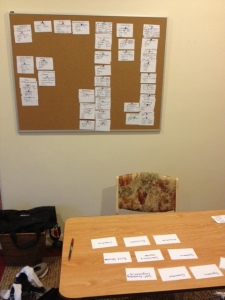Mark Crotty is Head at St. John’s Episcopal School in Dallas, another great school that I just did not have time to visit on my recently concluded national tour. He has been kind enough to follow via my blog, and over Thanksgiving posted on his own blog some of the questions that my reporting raised. I suggest you read his full text; he wonders if terms like “innovation” capture any real meaning as they are used and abused over time, if schools will fundamentally change or if this, too, shall pass.
“But, more than anything, I want some assurance that my hopes remain true possibilities. In at least some cases, even emerging realities. As I read his entries, I find myself asking pointed questions. For example, I will see that a school has implemented a new program or created a new position; and I wonder how it truly has changed the learning experience, if at all. Changing curricula does not guarantee anything; it may just emphasize different content. Adding an administrator does not ensure a pedagogical shift. I want to observe the classes. I want to talk with teachers. I want even more to talk with the students.”
I could not agree more with Mark. One of the real blessings of this trip was to listen to what people had to say, and then walk the walls and look for myself. Did I hear this school was “all-in” on changing to a more student-centric approach? Then why are the desks still lined up to a millimeter in rows, facing the front, where the teacher remains the focus of attention (or lack there-of)? When I asked students what made them want to get out of bed in the morning for one class and not another, they could not have been more clear, which lets us know that there are still many teachers at that school who are not shifting their pedagogy based on a measure of student engagement.
“Consequently, Grant has given me another hope: that when he finishes the journey, he can summarize the lessons learned in a way that enables to see what these schools have in common. How did they become transformative? Each entry has some of that, but I think we all would benefit from a synopsis from the person who has made the actual journey, because it strikes me that we’re talking about changing the DNA of many schools and educators. Then I hope we would see even more real innovation and not just school as we know it.”
 Well, Mark, I can assure you that I am going to do my best, and it started yesterday when I went out and bought two bulletin boards, screwed them into the wall of our family room, which has now been kitted out as my writing war room. I got my first affinity map posted up on the board. Since Thanksgiving I have gone back over all of my blogs and noted key take-aways on note cards, and am now mapping those into buckets of synthesis. As you might imagine, on those long drives of the last three months, a number of through-going ideas have emerged, and there is no question in mind that I will be able to articulate practices that lead to true changes in a school, as opposed to those that do not.
Well, Mark, I can assure you that I am going to do my best, and it started yesterday when I went out and bought two bulletin boards, screwed them into the wall of our family room, which has now been kitted out as my writing war room. I got my first affinity map posted up on the board. Since Thanksgiving I have gone back over all of my blogs and noted key take-aways on note cards, and am now mapping those into buckets of synthesis. As you might imagine, on those long drives of the last three months, a number of through-going ideas have emerged, and there is no question in mind that I will be able to articulate practices that lead to true changes in a school, as opposed to those that do not.
My work product will take several forms. A book is already in process, though I have not decided yet if it will take a traditional or innovative form. I have been asked to give a number of talks and workshop facilitations, including at TEDx Denver, The Martin Institute summer conference in June, and with various regional NAIS and NBOA-affiliated groups. I will also be working with individual schools that want to ensure they are taking advantage of what we know actually works.
Thanks again, Mark, for the most important step in problem-solving: asking the big, key questions!




Leave A Comment